Women's Suffrage & Birth Control: Historical Perspectives on Activism
VerifiedAdded on 2023/06/13
|6
|1248
|440
Essay
AI Summary
This essay delves into the women's suffrage movement in the United States and Europe, highlighting the century-long struggle for the right to vote and equality. It discusses the key events such as the Seneca Falls Convention and the eventual ratification of the 19th amendment in 1920, which enfranchised American women. The essay also examines the contributions of activists like Elizabeth Cady Stanton, Lucretia Mott, and Susan Anthony, as well as the formation of organizations like the National Women Suffrage Association (NAWSA) and the challenges faced, including racial exclusion within the movement. Furthermore, the essay explores the American birth control movement led by Margaret Higgins Sanger and Leta Hollingworth, emphasizing their advocacy for women's control over their bodies and access to contraceptives, despite facing legal challenges and criticism. The essay concludes by noting Sanger's impact and the support she received from figures like Martin Luther King, along with her efforts to promote birth control legislation.
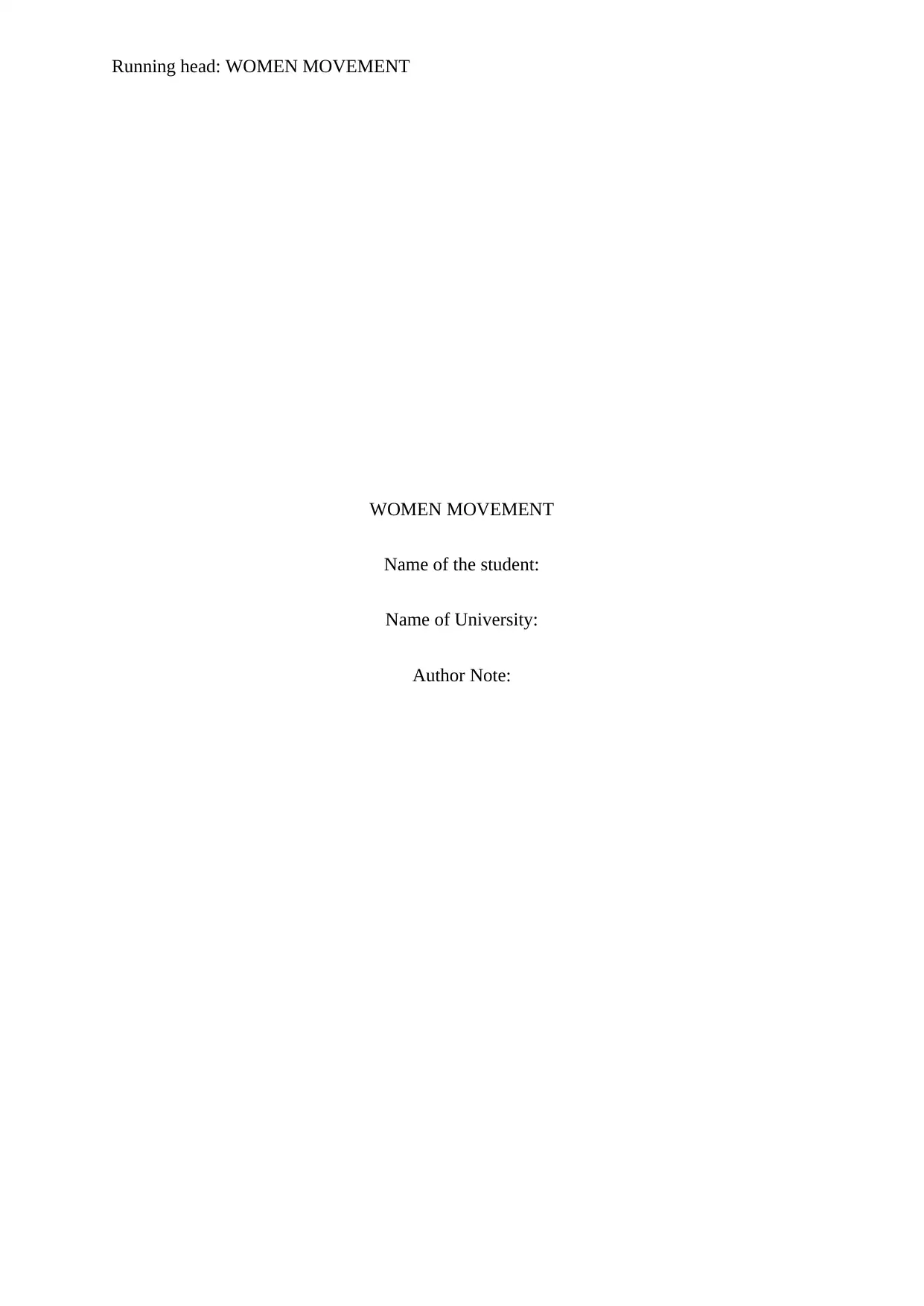
Running head: WOMEN MOVEMENT
WOMEN MOVEMENT
Name of the student:
Name of University:
Author Note:
WOMEN MOVEMENT
Name of the student:
Name of University:
Author Note:
Paraphrase This Document
Need a fresh take? Get an instant paraphrase of this document with our AI Paraphraser
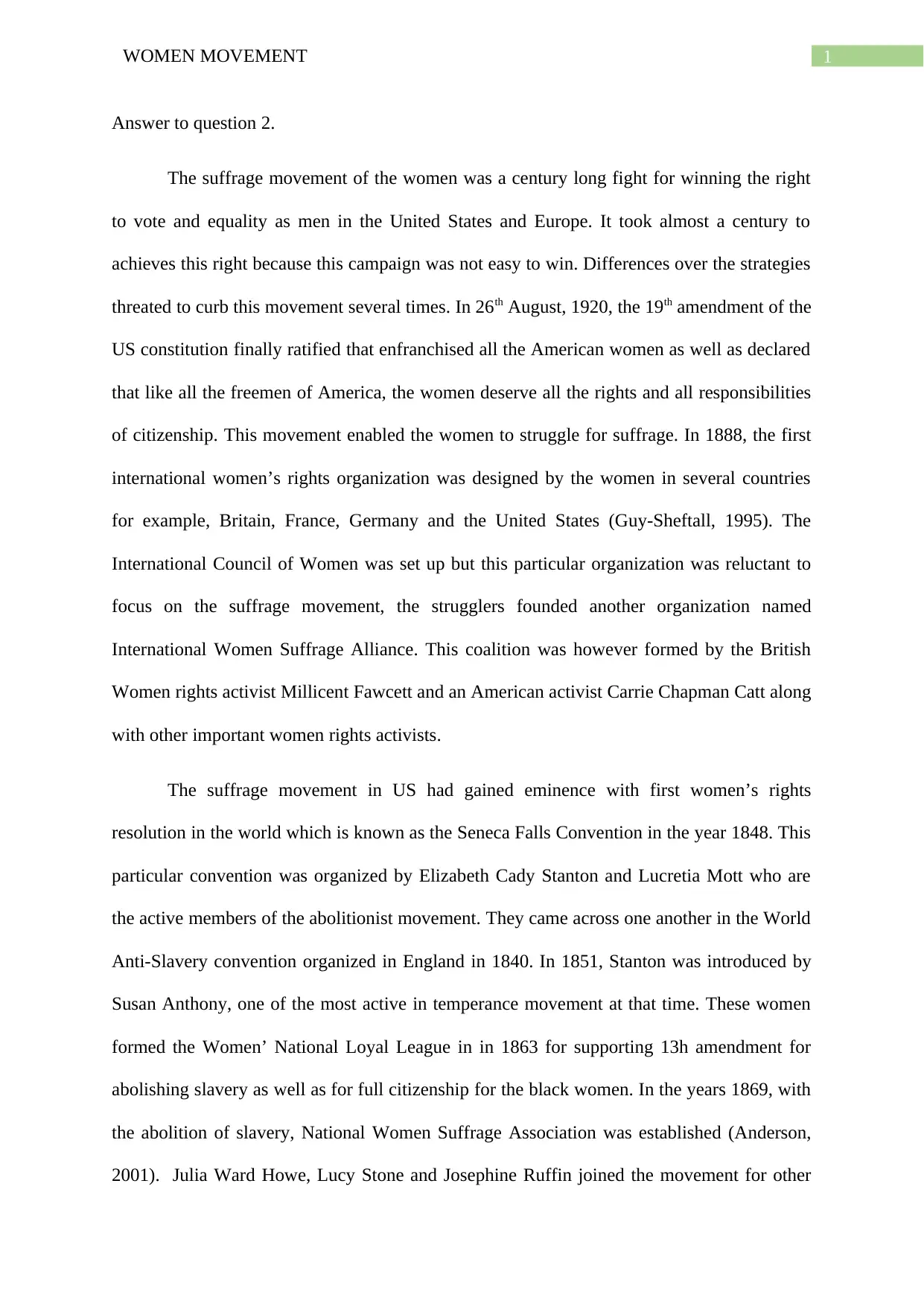
1WOMEN MOVEMENT
Answer to question 2.
The suffrage movement of the women was a century long fight for winning the right
to vote and equality as men in the United States and Europe. It took almost a century to
achieves this right because this campaign was not easy to win. Differences over the strategies
threated to curb this movement several times. In 26th August, 1920, the 19th amendment of the
US constitution finally ratified that enfranchised all the American women as well as declared
that like all the freemen of America, the women deserve all the rights and all responsibilities
of citizenship. This movement enabled the women to struggle for suffrage. In 1888, the first
international women’s rights organization was designed by the women in several countries
for example, Britain, France, Germany and the United States (Guy-Sheftall, 1995). The
International Council of Women was set up but this particular organization was reluctant to
focus on the suffrage movement, the strugglers founded another organization named
International Women Suffrage Alliance. This coalition was however formed by the British
Women rights activist Millicent Fawcett and an American activist Carrie Chapman Catt along
with other important women rights activists.
The suffrage movement in US had gained eminence with first women’s rights
resolution in the world which is known as the Seneca Falls Convention in the year 1848. This
particular convention was organized by Elizabeth Cady Stanton and Lucretia Mott who are
the active members of the abolitionist movement. They came across one another in the World
Anti-Slavery convention organized in England in 1840. In 1851, Stanton was introduced by
Susan Anthony, one of the most active in temperance movement at that time. These women
formed the Women’ National Loyal League in in 1863 for supporting 13h amendment for
abolishing slavery as well as for full citizenship for the black women. In the years 1869, with
the abolition of slavery, National Women Suffrage Association was established (Anderson,
2001). Julia Ward Howe, Lucy Stone and Josephine Ruffin joined the movement for other
Answer to question 2.
The suffrage movement of the women was a century long fight for winning the right
to vote and equality as men in the United States and Europe. It took almost a century to
achieves this right because this campaign was not easy to win. Differences over the strategies
threated to curb this movement several times. In 26th August, 1920, the 19th amendment of the
US constitution finally ratified that enfranchised all the American women as well as declared
that like all the freemen of America, the women deserve all the rights and all responsibilities
of citizenship. This movement enabled the women to struggle for suffrage. In 1888, the first
international women’s rights organization was designed by the women in several countries
for example, Britain, France, Germany and the United States (Guy-Sheftall, 1995). The
International Council of Women was set up but this particular organization was reluctant to
focus on the suffrage movement, the strugglers founded another organization named
International Women Suffrage Alliance. This coalition was however formed by the British
Women rights activist Millicent Fawcett and an American activist Carrie Chapman Catt along
with other important women rights activists.
The suffrage movement in US had gained eminence with first women’s rights
resolution in the world which is known as the Seneca Falls Convention in the year 1848. This
particular convention was organized by Elizabeth Cady Stanton and Lucretia Mott who are
the active members of the abolitionist movement. They came across one another in the World
Anti-Slavery convention organized in England in 1840. In 1851, Stanton was introduced by
Susan Anthony, one of the most active in temperance movement at that time. These women
formed the Women’ National Loyal League in in 1863 for supporting 13h amendment for
abolishing slavery as well as for full citizenship for the black women. In the years 1869, with
the abolition of slavery, National Women Suffrage Association was established (Anderson,
2001). Julia Ward Howe, Lucy Stone and Josephine Ruffin joined the movement for other
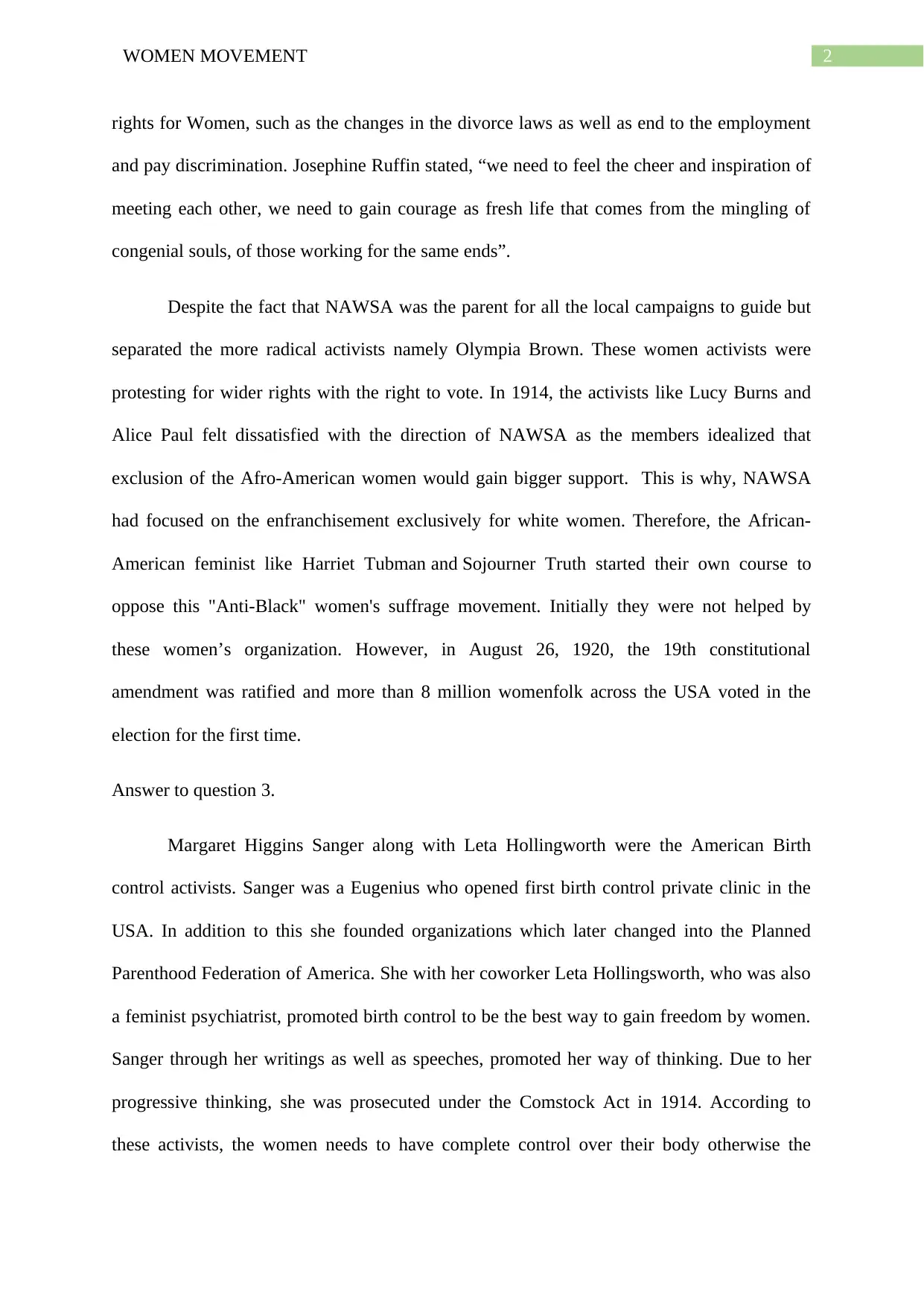
2WOMEN MOVEMENT
rights for Women, such as the changes in the divorce laws as well as end to the employment
and pay discrimination. Josephine Ruffin stated, “we need to feel the cheer and inspiration of
meeting each other, we need to gain courage as fresh life that comes from the mingling of
congenial souls, of those working for the same ends”.
Despite the fact that NAWSA was the parent for all the local campaigns to guide but
separated the more radical activists namely Olympia Brown. These women activists were
protesting for wider rights with the right to vote. In 1914, the activists like Lucy Burns and
Alice Paul felt dissatisfied with the direction of NAWSA as the members idealized that
exclusion of the Afro-American women would gain bigger support. This is why, NAWSA
had focused on the enfranchisement exclusively for white women. Therefore, the African-
American feminist like Harriet Tubman and Sojourner Truth started their own course to
oppose this "Anti-Black" women's suffrage movement. Initially they were not helped by
these women’s organization. However, in August 26, 1920, the 19th constitutional
amendment was ratified and more than 8 million womenfolk across the USA voted in the
election for the first time.
Answer to question 3.
Margaret Higgins Sanger along with Leta Hollingworth were the American Birth
control activists. Sanger was a Eugenius who opened first birth control private clinic in the
USA. In addition to this she founded organizations which later changed into the Planned
Parenthood Federation of America. She with her coworker Leta Hollingsworth, who was also
a feminist psychiatrist, promoted birth control to be the best way to gain freedom by women.
Sanger through her writings as well as speeches, promoted her way of thinking. Due to her
progressive thinking, she was prosecuted under the Comstock Act in 1914. According to
these activists, the women needs to have complete control over their body otherwise the
rights for Women, such as the changes in the divorce laws as well as end to the employment
and pay discrimination. Josephine Ruffin stated, “we need to feel the cheer and inspiration of
meeting each other, we need to gain courage as fresh life that comes from the mingling of
congenial souls, of those working for the same ends”.
Despite the fact that NAWSA was the parent for all the local campaigns to guide but
separated the more radical activists namely Olympia Brown. These women activists were
protesting for wider rights with the right to vote. In 1914, the activists like Lucy Burns and
Alice Paul felt dissatisfied with the direction of NAWSA as the members idealized that
exclusion of the Afro-American women would gain bigger support. This is why, NAWSA
had focused on the enfranchisement exclusively for white women. Therefore, the African-
American feminist like Harriet Tubman and Sojourner Truth started their own course to
oppose this "Anti-Black" women's suffrage movement. Initially they were not helped by
these women’s organization. However, in August 26, 1920, the 19th constitutional
amendment was ratified and more than 8 million womenfolk across the USA voted in the
election for the first time.
Answer to question 3.
Margaret Higgins Sanger along with Leta Hollingworth were the American Birth
control activists. Sanger was a Eugenius who opened first birth control private clinic in the
USA. In addition to this she founded organizations which later changed into the Planned
Parenthood Federation of America. She with her coworker Leta Hollingsworth, who was also
a feminist psychiatrist, promoted birth control to be the best way to gain freedom by women.
Sanger through her writings as well as speeches, promoted her way of thinking. Due to her
progressive thinking, she was prosecuted under the Comstock Act in 1914. According to
these activists, the women needs to have complete control over their body otherwise the
⊘ This is a preview!⊘
Do you want full access?
Subscribe today to unlock all pages.

Trusted by 1+ million students worldwide
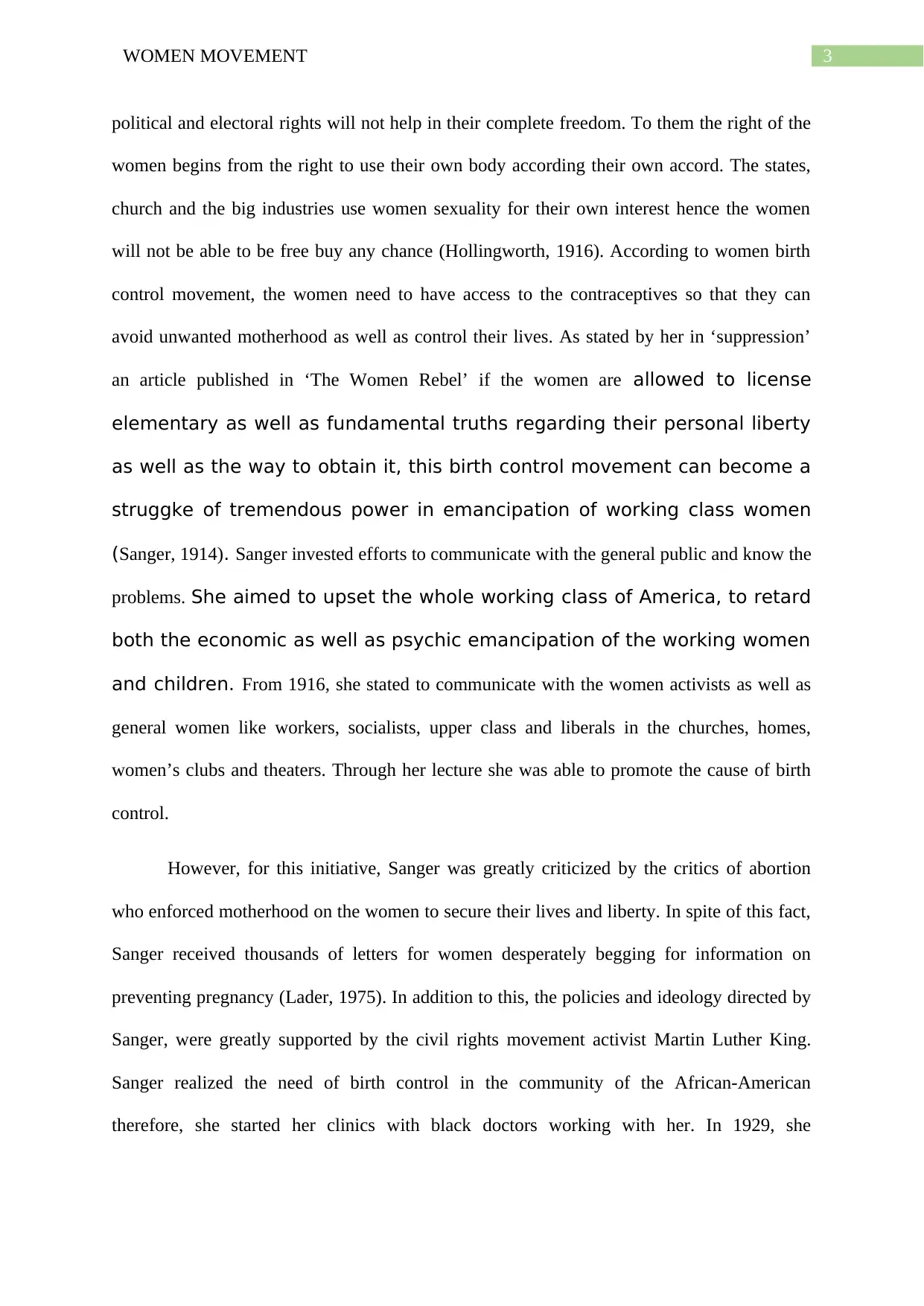
3WOMEN MOVEMENT
political and electoral rights will not help in their complete freedom. To them the right of the
women begins from the right to use their own body according their own accord. The states,
church and the big industries use women sexuality for their own interest hence the women
will not be able to be free buy any chance (Hollingworth, 1916). According to women birth
control movement, the women need to have access to the contraceptives so that they can
avoid unwanted motherhood as well as control their lives. As stated by her in ‘suppression’
an article published in ‘The Women Rebel’ if the women are allowed to license
elementary as well as fundamental truths regarding their personal liberty
as well as the way to obtain it, this birth control movement can become a
struggke of tremendous power in emancipation of working class women
(Sanger, 1914). Sanger invested efforts to communicate with the general public and know the
problems. She aimed to upset the whole working class of America, to retard
both the economic as well as psychic emancipation of the working women
and children. From 1916, she stated to communicate with the women activists as well as
general women like workers, socialists, upper class and liberals in the churches, homes,
women’s clubs and theaters. Through her lecture she was able to promote the cause of birth
control.
However, for this initiative, Sanger was greatly criticized by the critics of abortion
who enforced motherhood on the women to secure their lives and liberty. In spite of this fact,
Sanger received thousands of letters for women desperately begging for information on
preventing pregnancy (Lader, 1975). In addition to this, the policies and ideology directed by
Sanger, were greatly supported by the civil rights movement activist Martin Luther King.
Sanger realized the need of birth control in the community of the African-American
therefore, she started her clinics with black doctors working with her. In 1929, she
political and electoral rights will not help in their complete freedom. To them the right of the
women begins from the right to use their own body according their own accord. The states,
church and the big industries use women sexuality for their own interest hence the women
will not be able to be free buy any chance (Hollingworth, 1916). According to women birth
control movement, the women need to have access to the contraceptives so that they can
avoid unwanted motherhood as well as control their lives. As stated by her in ‘suppression’
an article published in ‘The Women Rebel’ if the women are allowed to license
elementary as well as fundamental truths regarding their personal liberty
as well as the way to obtain it, this birth control movement can become a
struggke of tremendous power in emancipation of working class women
(Sanger, 1914). Sanger invested efforts to communicate with the general public and know the
problems. She aimed to upset the whole working class of America, to retard
both the economic as well as psychic emancipation of the working women
and children. From 1916, she stated to communicate with the women activists as well as
general women like workers, socialists, upper class and liberals in the churches, homes,
women’s clubs and theaters. Through her lecture she was able to promote the cause of birth
control.
However, for this initiative, Sanger was greatly criticized by the critics of abortion
who enforced motherhood on the women to secure their lives and liberty. In spite of this fact,
Sanger received thousands of letters for women desperately begging for information on
preventing pregnancy (Lader, 1975). In addition to this, the policies and ideology directed by
Sanger, were greatly supported by the civil rights movement activist Martin Luther King.
Sanger realized the need of birth control in the community of the African-American
therefore, she started her clinics with black doctors working with her. In 1929, she
Paraphrase This Document
Need a fresh take? Get an instant paraphrase of this document with our AI Paraphraser
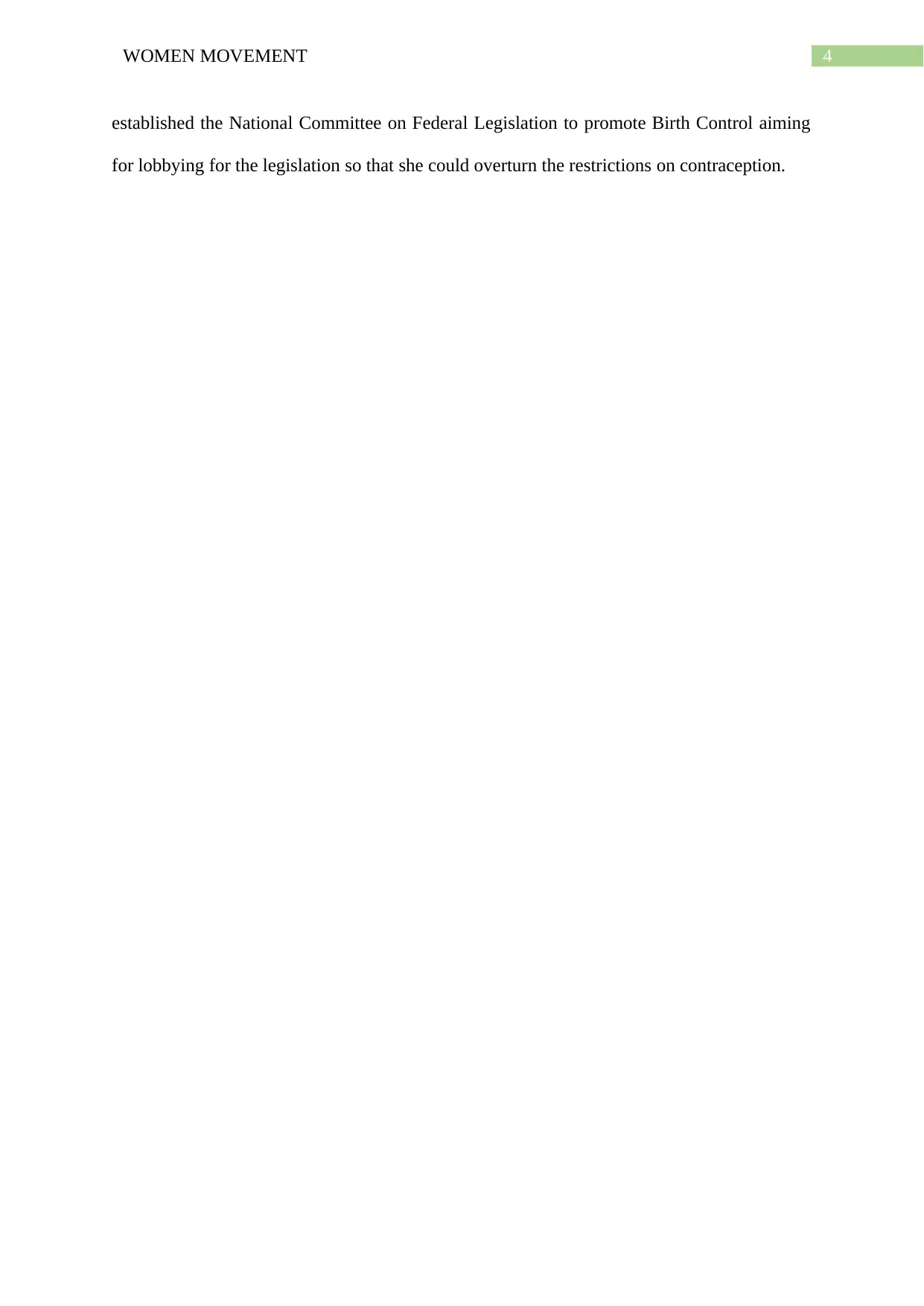
4WOMEN MOVEMENT
established the National Committee on Federal Legislation to promote Birth Control aiming
for lobbying for the legislation so that she could overturn the restrictions on contraception.
established the National Committee on Federal Legislation to promote Birth Control aiming
for lobbying for the legislation so that she could overturn the restrictions on contraception.
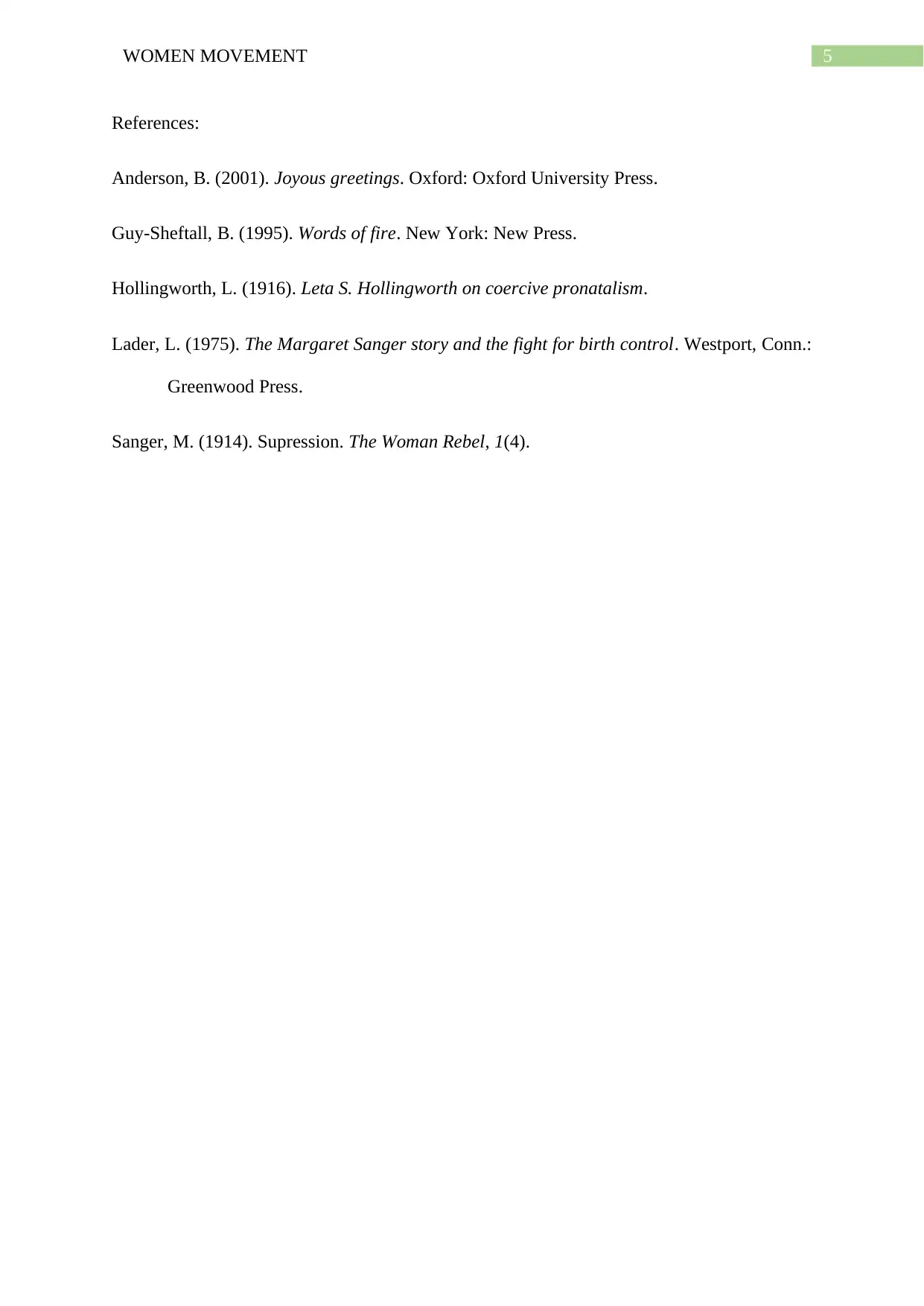
5WOMEN MOVEMENT
References:
Anderson, B. (2001). Joyous greetings. Oxford: Oxford University Press.
Guy-Sheftall, B. (1995). Words of fire. New York: New Press.
Hollingworth, L. (1916). Leta S. Hollingworth on coercive pronatalism.
Lader, L. (1975). The Margaret Sanger story and the fight for birth control. Westport, Conn.:
Greenwood Press.
Sanger, M. (1914). Supression. The Woman Rebel, 1(4).
References:
Anderson, B. (2001). Joyous greetings. Oxford: Oxford University Press.
Guy-Sheftall, B. (1995). Words of fire. New York: New Press.
Hollingworth, L. (1916). Leta S. Hollingworth on coercive pronatalism.
Lader, L. (1975). The Margaret Sanger story and the fight for birth control. Westport, Conn.:
Greenwood Press.
Sanger, M. (1914). Supression. The Woman Rebel, 1(4).
⊘ This is a preview!⊘
Do you want full access?
Subscribe today to unlock all pages.

Trusted by 1+ million students worldwide
1 out of 6
Your All-in-One AI-Powered Toolkit for Academic Success.
+13062052269
info@desklib.com
Available 24*7 on WhatsApp / Email
![[object Object]](/_next/static/media/star-bottom.7253800d.svg)
Unlock your academic potential
Copyright © 2020–2025 A2Z Services. All Rights Reserved. Developed and managed by ZUCOL.


